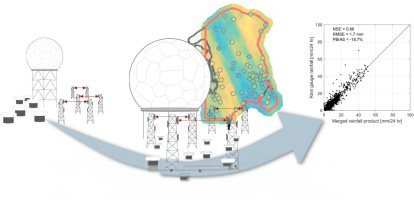Accurate rainfall estimates with high spatiotemporal resolution are vital for urban drainage applications, and if adjusted to ground observations, weather radar data has potential for these applications.
The density of meteorological rain gauges for adjustment is, however, often sparse and non-uniformly distributed in space. Opportunistic rainfall sensors provide an increased density of ground observations but often with reduced or unknown accuracy for each individual station. This paper demonstrates the merging of data from weather radar, personal weather stations, and commercial microwave links into an integrated rainfall product. Merging opportunistic rainfall estimates is shown to improve the accuracy of the opportunistic rainfall observations through a quality control algorithm. In this study, we show that the accuracy of rainfall estimates is significantly improved by merging opportunistic rainfall data and weather radar data when compared to the accuracy of each rainfall product without merging. Nash-Sutcliffe efficiency (NSE) values up to 0.88 are obtained for daily accumulated merged rainfall products, while the NSE-values of the individual rainfall products range from −7.44 to 0.65, and similar tendencies are observed for root mean squared error (RMSE) values. For merging weather radar and opportunistic rainfall data, a novel approach, i.e., “moving median bias adjustment” is presented. Applying this approach, a high-performing rainfall product is derived independently from conventional high-quality rain gauges, which in this study are only used for independent validation. In addition, it is demonstrated that accurate rainfall estimates can be obtained by sub-daily merging, underscoring the importance of merging in nowcasting and near real-time applications.
Post time: May-16-2024


